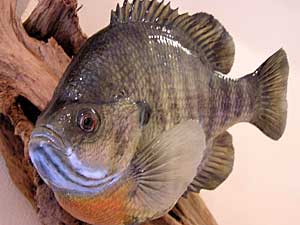|
Audio
Photos
Resources
|
May 12, 2005
Some anglers have a huge walleye hanging above the fireplace. Others have a colorful trout on display in the den. Whatever they've caught, people love to show off their trophy fish. But tighter regulations means more of them are releasing their big catch instead of mounting it on the wall. Because of that, one central Minnesota taxidermist says anglers are choosing a new way to preserve the memory of a successful day on the water.
Hawick, Minn. — Lou Wynia has seen his share of big fish. After more than 30 years as a taxidermist, countless anglers have come through his doors, asking to have their catch preserved and mounted. But these days he's seeing fewer fish in the flesh come into his Hawick area business. Wynia thinks that's because of the growing popularity of catch and release.
"They're finding it's rewarding to turn that fish loose and somebody else can catch it someday," Wynia said.
Tighter fishing regulations play a huge part too. On many lakes, anglers are forced to throw back their prize catch, so the big ones sometimes really do get away. Often that leaves fisherman with nothing more than a photo. But they can still hang something on their wall if they opt for a replica of their fish.
It all starts by sending in a picture. Wynia shows off a recent e-mailed image of a North Dakota fisherman proudly hoisting a 15-pound walleye caught in Idaho.
"He sent us the photo and a little bit of a story with how he caught it. Believe it or not his friend caught another 15-pounder the same day, so they're each having one done. You can see he's got a pretty good grin on his face."
Using the photo as a guide, employees in a workshop next to Wynia's office create a fish out of rubber and silicone with the exact same proportions. Among the half-dozen workers here, a couple are hunched over stark white silicone fish bodies, grinding and sanding away until things look just right. Everything is made from a mold of an actual fish, so even the teeth and the inside of the mouth look real.
Once everything is put together, Wynia paints the fish with life-like colors. The result is a replica that he thinks looks better than a traditional mounted version, which are made by skinning a fish, and then stretching it over a styrofoam mold. At about $15 an inch, replicas cost more than skin mounts. But Wynia says those can start to look old after a few years, something fish replicas won't do. With that in mind, he's seeing more anglers come around to the idea of replicas. Just a few years ago, Wynia says most people wanted the actual fish they caught mounted. And now he says 95 percent of his business is making fake fish.
"They're much more willing to take a replica today. You can let your fish go and still put it on the wall too. It's a neat thing," Wynia said.
And if you're wondering about anglers who might stretch the truth a bit and order a bigger fish than they caught, Wynia says despite the cliché, fisherman are honest.
"Most sportsmen are pretty straight up. I'm not going to say there's not the exception out there. But for the most part, if a guy gets a 29 inch walleye, that's what he wants on his wall is a 29 inch walleye," Wynia said.
Lou Wynia thinks replicas are the future of fish taxidermy. He's had to hire several more employees in the past few years to help fill orders coming in from all over the country. Right now he sends out 50 a month and expects he'll only get busier. The wait to get one of his completed replica fish is six months to a year.






